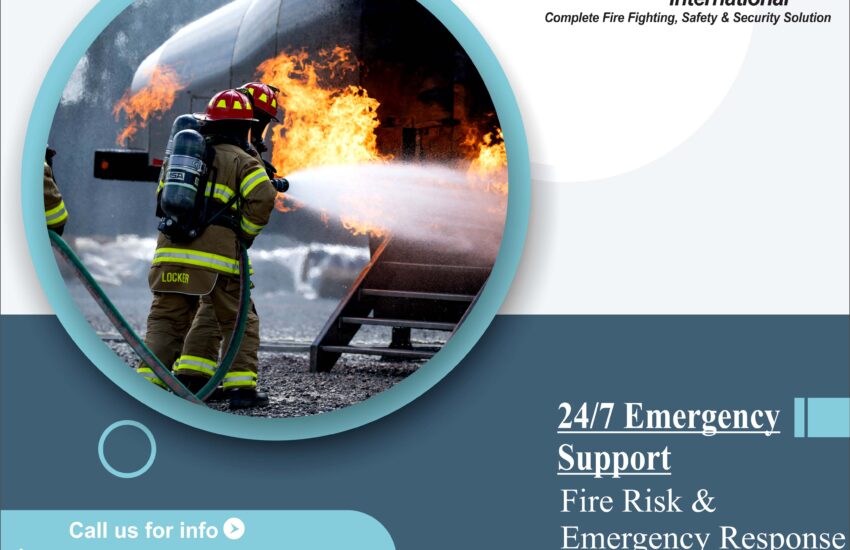Fire Risk & Emergency Response In both residential and commercial environments, the threat of fire hazards is real and potentially devastating. Fires can cause injury, loss of life, business disruption, and significant property damage. Implementing comprehensive fire risk assessments and emergency response plans is essential for safeguarding people, assets, and infrastructure.
This article outlines essential fire risk and emergency response strategies, with a focus on prevention, preparedness, and response measures.
🚨 What Is Fire Risk?
Fire risk refers to the likelihood of a fire occurring and the potential consequences it can cause. It is influenced by various factors including:
- Flammable materials
- Electrical equipment
- Human error
- Poor building maintenance
Proper assessment helps in identifying vulnerabilities and minimizing potential fire outbreaks.
🔍 Fire Risk Assessment: A Crucial First Step
A fire risk assessment is a structured evaluation of a property to:
- Identify fire hazards
- Determine who is at risk
- Evaluate existing safety measures
- Recommend improvements
- Record findings and develop an action plan
It should be conducted regularly and whenever changes occur in the building or operations.
🛡️ Fire Prevention Strategies
Prevention is always better than cure. Key fire prevention steps include:
- Regular electrical inspections
- Safe storage of flammable materials
- No smoking policies
- Proper maintenance of machinery and equipment
- Clear safety signage and instructions
These proactive steps significantly reduce the chance of fire ignition.
🧑🚒 Fire Safety Measures & Equipment
Every building must be equipped with essential safety systems, such as:
- Fire extinguishers for different fire classes
- Smoke and heat detectors
- Automatic sprinkler systems
- Fire alarm systems
- Fire doors and fire-resistant materials
Routine maintenance and testing of these systems ensure functionality in an emergency.
🏃 Emergency Response Plan
An effective emergency response plan outlines the actions to take in case of a fire. This includes:
- Evacuation routes and exits
- Fire warden responsibilities
- Communication protocols
- Emergency services coordination
- Assembly points
The plan should be clearly communicated and visible throughout the building.
🧑🏫 Fire Safety Training
All personnel must undergo safety training, covering:
- Use of fire extinguishers
- Recognizing fire hazards
- Evacuation procedures
- Roles during emergencies
Conduct regular fire drills to test readiness and reinforce training.
🧭 Roles of the Fire Response Team
A designated fire response team ensures quick, organized action during emergencies. Key roles include:
- Fire wardens to guide evacuation
- Incident commanders to lead the response
- First aid responders to assist injured individuals
- Communication liaisons to coordinate with emergency services
Training and readiness of this team are vital for an effective response.
🏢 Building Safety Compliance
Ensure that your property complies with local and international fire safety regulations. This may include national fire protection standards, occupational safety laws, and municipal codes.
Non-compliance can result in fines, closures, or legal action.
📋 Fire Emergency Preparedness Checklist
Use a fire emergency preparedness checklist to stay ready:
- Fire extinguishers inspected
- Exits clearly marked and unblocked
- Alarms functional
- Emergency contact numbers posted
- Drills conducted
- Staff training up to date
🌍 Industry-Specific Fire Risk Considerations
Every industry has unique fire risks:
- Construction sites: flammable materials and open flames
- Healthcare facilities: patient evacuation complexity
- Industrial plants: hazardous chemicals and machinery
- Offices: electrical equipment and paper storage
Tailor your fire emergency response accordingly.
📈 Benefits of Fire Risk Management
Proper fire risk management leads to:
- Improved employee safety
- Reduced property damage
- Compliance with laws
- Lower insurance premiums
- Faster emergency response
It’s a smart investment in business continuity.
🧠 Conclusion: Be Ready Before the Flames Start
Fires can start suddenly, but their effects can be devastating. By implementing a robust fire risk assessment, maintaining safety equipment, training your staff, and developing a clear emergency response plan, you can protect both lives and assets. Don’t wait for disaster to strike—act now to mitigate fire risks.


